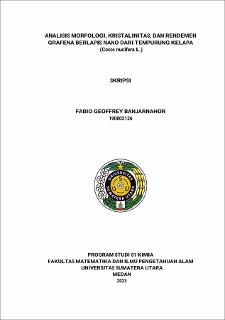Analisis Morfologi, Kristalinitas, dan Rendemen Grafena Berlapis Nano dari Tempurung Kelapa (Cocos nucifera L.)
Analysis of Morphology, Crystallinity and Yield of Nanocoated Graphene from Coconut Shells (Cococ nucifera L.)

Date
2023Author
Banjarnahor, Fabio Geoffrey
Advisor(s)
Siburian, Rikson Asman Fertiles
Metadata
Show full item recordAbstract
Research on morphology analysis, crystallinity and yield of Graphene Nano Sheets
from coconut shells using the pyrolysis method has been carried out. The use
of coconut shell in this research is because it contains 33,61 % cellulose and 19,27%
hemicellulose and has a very high carbon content. The aim of this research is to
determine the optimum conditions of temperature and pyrolysis time in converting
coconut shells into GNS and to evaluate the morphology, crystallinity and yield of
GNS from coconut shells Is due to variations in temperature and pyrolysis time. This
research is a laboratory experimental research. GNS was synthesized using the
pyrolysis method, and GNS products from each variation of temperature and
pyrolysis time were characterized using X-Ray Diffraction (XRD), Scanning Electron
Microscopy Energy Dispersive X-Ray (SEM-EDX), and Fourier Transform Infrared
(FTIR). XRD data from GNS shows that there is a weak and wide peak at C (002)
(20 = 24. 7°), meaning that graphene was successfully produced. This XRD data is
supported by SEM-EDX data, GNS has a regular hexagonal morphology, is very
dense and resembles a honeycomb and has an aromatic Csp2 structure (FTIR data).
GNS is dominated by carbon atoms (C) 80 - 84% and oxygen (0) 12-19% (EDX
data). The optimum pyrolysis conditions (temperature (T Plrolys1s) and pyrolysis time
(tPyrolysis)) in the GNS production process are TPirolysis = 400 °C; tPyrolysis I & II = 4
and 1 hour. With a carbon composition (87.3%). All data shows that GNS can be
produced from coconut shell raw materials with the best yield is 21.5 % (w/w)
(Rendement data). Show that the research data the coconut shells are potentially as
a raw material to product a large scale of GNS.
Collections
- Undergraduate Theses [1412]
